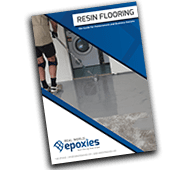Home › Advice › Know How › Knowhow
5 Good Habits for Epoxy Flooring Application
There’s nothing I love more than simple stuff that makes a big difference. You know, those warm and fuzzy
moments when you think to yourself, “Wow, that’s gonna make things a whole lot easier!”
In the previous post, Epoxy application - bad application habits, I gave you some of the worst pound-for-pound application habits going around; the stuff that bobs up time and again as the cause for very avoidable problems. As promised, here is the other side of the coin. The following are all pretty simple application habits that may not sound particularly ground-breaking, however they’re guaranteed to give you those moments I speak of and make your life as an epoxy contractor a whole lot easier. Enjoy!
Use cotton “inners”
I always insist on wearing disposable gloves, typically latex because they are cheap and readily available. There are a couple of things I
don’t like about them though:
-
Sweat - a big problem with these gloves is the sweat, which can do a couple of bad things: it can run down your arm and onto a wet film,
and, it can react with the powder in the gloves to cause skin sensitivity. I buy powder-free gloves to avoid the sensitivity issue, but
these are near impossible to put on with sweaty hands.
- Padding - the other problem is they are no good for holding onto tools because they offer no padding or protection.
Here is a great tip to overcome both of those pains: use thin cotton gloves underneath. You won’t realise how much of a difference it makes
in both of these departments until you give it a shot!

Wear an apron over your work clothes
I actually started wearing an apron as a bit of fun for my decorative flooring range, but the more I used them the more I liked the
idea. Not only did they protect my work clothes, but the pockets were very handy for storing rags, gloves etc., and I no longer needed
to walk off the floor to replace the consumable items because I carried them with me. While you’re at it, you might also want to grab
yourself some sweat bands and even head bands. Items like these are a blessing when you’re at full throttle in hot, humid conditions and
trying to stop sweat dripping all over the floor.
On clothing, I’d like to quickly comment on the broader topic of presentation. Work clothes are always going to cop a bit of punishment, but it isn’t a good look to have finger prints all over and smears everywhere. The client will probably be thinking, “If they can’t keep their work clothes clean, what will they do to my walls?” My suggestion is to have a nice, clean set for meetings and inspections because it will set you apart from others turning up in their soiled gear.
Squirter bottles for clean up
Here’s a great little tip for contractors wanting to take their cleanliness and safety to the next level: put your solvent in a squirter
bottle. It gives you so much more control over the amount used and is far better for your health than slouching over an open bucket. The
pointed nozzle also gets into all the hard-to-reach places for a thorough clean of your tools! If you're interested, I've written a
separate post on the effective clean up of epoxy resins.
Roll out the carpet!
Contractors who like to work clean will use some form of dropsheet, with most being made of plastic that can be slippery, light and flimsy.
If you’re after something more robust and easier to control, I’ve known a few contractors that carry around a roll of old carpet instead.
The carpet is simply rolled out at the start over a plastic dropsheet and back up again after they’re done. All the little drops and drips
are absorbed into the pile and there’s nothing to dispose of. Brilliant!
Get your diamonds right
One of the best tips to save you time, money, and perhaps even your sanity, is to develop a better understanding of your grinder and be
willing to invest in the right set-up. The fact is there can be a big difference in how concrete grinds from one slab to the next. For
instance, hard concrete tends to produce ultra fine dust, which doesn’t abrade well and can result in hard discs glazing over and losing
their efficiency. With this in mind, hitting every slab with the same grinding disc because you don’t want to fork out on multiple sets of
diamonds will only end up costing you more in extra labour and perhaps even coating failures.
One last bonus tip...
Just to finish off I thought I’d hand over one last tip mainly because it’s such a simple fix for a rather costly mistake. If you use a
drill mixer and you’re not able to release the mixing paddle each time, tape up your chuck so that when you lay the drill down the resins
don’t run along the shaft and into the chuck. Funnily enough, this tip actually came from one of my more experienced contractors who had to
replace two drill chucks within a very short space of time and was desperate to avoid a third!
So, there we go. Five very simple, yet very effective application habits I know you’ll love if you give them a try. What other simple, good
application habits do you have? I’m sure we’d all love to hear more!
-
Learning - Learn more about the good and bad epoxy flooring application habits with our online courses:
- Epoxy Flooring Short Courses
- Bronze Card Course
- Silver Card Course
-
Ask a question - If you have any questions you'd like to ask us about this topic, hit the support button below:
_800x271a.png)
